Meditation on Pomegranates
If you buy a pomegranate,
buy one whose ripeness
has caused it to be cleft open
with a seed-revealing smile.
Its laughter is a blessing,
for through its wide-open mouth
it shows its heart,
like a pearl in the jewel box of spirit.
The red anemone laughs, too,
but through its mouth you glimpse a blackness.
A laughing pomegranate
brings the whole garden to life.
– The Laughter of Pomegranates ― Rumi
It’s a soft still autumn afternoon, warmer than is usual for this time of the year, when I visit Janni Kyritsis at his apartment in Sydney’s Potts Point.
Janni is one of Australia’s most highly awarded chefs (ex Stephanie’s in Melbourne, Berowra Waters Inn, Bennelong and MG Garage) and I’ve come to talk to him about pomegranates, among other things.
I find a parking spot out the front and he waves to me from his elegant first floor balcony.
“I’ll open the front door for you,” he says.
But as he presses the remote control, the friendly dog which greeted me in the garden rushes in to the lobby, wagging its tail.
Janni comes down stairs, speaks quietly to the dog and leads it back out into the garden. I follow him up the wide staircase and into his apartment. It’s warm in there.
“I can’t stand the cold,” he tells me in his softly lilting voice. “I always have the heating on.”
My eyes alight on a bowl of pomegranates he has placed on a wooden table outside on the balcony. A spray of bougainvillea droops from above, and the scene reminds me of a still life painting.
“Would you like some coffee?’ he asks. “Or maybe tea? I have some peach tea here which you might like.”
He goes into the kitchen and takes a canister from a shelf. He takes off the lid and waves it under my nose.
“Hmmm..yes, I’d like to try some of that.”
He puts on the kettle, scurries around for the silver teapot, warms it and makes the tea. He suggests I drink it with some lime and puts a few slices of fresh lime on a plate.
We take the peach tea and lime slices out on to the balcony. He pours the tea, using a tea-towel to grip the hot handle, drops in a slice of fragrant lime and we begin to chat about pomegranates.
“There were a lot of pomegranate trees growing nearby when I was a child in Kavalla, Greece,” he says. “We used to cut the fruit open and eat the seeds from the centre.
“The important thing is that they must be very ripe and look a little tired on the outside. Just like passionfruit, they’re better when they’re a little soft and squishy because they will release their seeds easily.”
He takes a small sharp knife and shows me the best way to release the seeds.
First, he runs it all the way around the thorny crown.
Then he makes four light incisions into the skin, as you do when cutting an orange into quarters, a precise operation because he doesn’t cut through to the centre of the fruit as the skin and pith are very bitter so the less you cut through, the better. He pulls out one of the quarters out, revealing the glistening ruby seeds inside.
It’s a much gentler way of releasing the seeds than Jamie Oliver’s method of bashing the halved fruit with a wooden spoon.
“I have loved pomegranates since I was a child growing up in Kavalla, Greece. As a boy, I was never allowed in the kitchen but I remember how we used to eat the seeds from the centre as if they were little jewels,” he says.
“I remember people hanging their pomegranates outside the house. The seeds inside would stay moist and the outer skin would become dry. At Christmas, they’d bring them inside and smash them on the floor as a sign of fertility.”
Those early memories lingered and he carried them with him on the long journey by ship to Australia over 40 years ago. As a professional chef, he has created many inspirational modern dishes using both the seeds and juice, though he still bows to tradition with dishes such as kolyva.
According to Greek food writer Aglaia Kremezi in her book The Foods of Greece, kolyva is one of the traditional symbolic sweets prepared to mark nine days, forty days or one year on from a beloved person’s death. In ancient Greek the word meant “small coin” or “small golden weight” as well as “small cakes” and refers to a mixture of grains (polysporia) offered by ancient Greeks to their gods, specifically Demeter (Ceres), the goddess of agriculture.
Each year to commemorate the passing of his partner, David Bradshaw, Janni makes a kolyva with wheatberries, spices, nuts and dried fruit, shapes it into a mound, covers it with toasted flour, dusts it with icing sugar and decorates it with pomegranate seeds and sugared almonds.
Friends are invited around to share a meal and partake of Janni’s kolyva.
In Greek mythology, pomegranates are closely associated with the underworld, so it is no surprise that the seeds are used to garnish the kolyva.
According to the myth, Persephone, daughter of Demeter, goddess of agriculture, made the fatal mistake of eating six of the seeds when in the underworld. This condemned her to spend six months of the year there with Hades, her dark husband.
The story is an allegory of the dormancy of vegetable life during the winter and the promise of rebirth in the spring.
According to Jungian psychologist James Hillman, it is in the underworld that seeds germinate and prepare for spring. Myths of descent and rebirth connect the soul’s cycles to those of nature.
Even today, Sephardic Jews set bowls of pomegranates on the table at New Year (Rosh Hashanah).
Janni’s kolyva is a work of art with its sparkling pomegranates seeds, silver cachous, pine nuts and sugared almonds.
Speaking of works of art, he tells me that he created a pomegranate jelly and granita recipe specifically to celebrate Margaret Olley’s painting of pomegranates. Olley is a renowned Australian still life painter.
“For me, this painting makes the fruit come alive,” he says. “As if they are coming out of the canvas ready to be eaten. Olley has captured the naturalness of the pomegranate and the beautiful colour that represents the fruit’s peak ripeness. It is a sensory thing for me, just like going to the greengrocer where you can feel, smell and experience the produce.
“It inspired me to keep the pomegranate’s natural flavour as much as possible. I have been cooking for 30 years and I love using pomegranates in a variety of dishes, with grilled lamb or duck and in Persian pomegranate and walnut stuffing. It is a wonderful ingredient in so many dishes.”
He suggests freezing the seeds, if you have the time.
“After they have defrosted, you will get more juice out of them,” he says.
“Place a piece of plastic film over them as you squeeze them, that way the juice will not go over the kitchen because it stains everything.
“I use this freezing method for passionfruit and other berries where the juice clings to the seeds. There is no sweetener required as the pomegranate juice has the perfect balance of fruit flavour, acidity and sweetness. The cold granita and smooth jelly creates a perfect texture.”
It is also perfect diabetic food and one he included in the cookbook At My Table (Allen & Unwin) which he co-authored with Amanda Bilson.
This is his recipe:
Serves 6
Pomegranate Jelly
6 pomegranates (approximately) – cut the skin like an orange in quarters, carefully with the help of a knife crack the pomegranate making sure you don’t cut through the skin and pips because that it the bitter part, take out all the seeds and squeeze them through a sieve. Depending on the quality of the fruit you should have 600 mls of pomegranate juice.
600mls pomegranate juice
2 teaspoons gelatine (or 4 gelatine leaves soaked in water)
Place 100 mls pomegranate juice in a small saucepan sprinkle gelatine on the juice and after a few minutes warm the juice to just melt the gelatine thoroughly, mix with the rest of the juice, pass through a sieve and set in 6 martini glasses or any glasses of your choice.
Tip: 2 teaspoons of gelatine is for a light set, if you prefer it to set a bit more use an extra teaspoon.
Pomegranate Granita
6 pomegranates prepared as per Jelly into a juice.
Place juice into a tray in the freezer and as it starts setting scrape with a fork into a granita.
To Serve:
Spoon granita on top of the jelly and serve. Use very ripe pomegranates and if they are left out for a few days – if the skin looks a bit dry they will be even better inside.
Like the fig, the pomegranate is one of the oldest fruits in cultivation, and as such is steeped in myths and legend. Its glistening grain-like seeds seem always to have captured the imagination. Like the fig, its origins are somewhere in the Middle East.
Biblical references abound – Moses promised the wandering Israelites “a land of wheat and barley and vines and fig trees and pomegranates”; Solomon had a pomegranate orchard.
Its juice was much prized and was used by herbalists for many disorders.
Granada in Spain is thought to have been named after the pomegranate and the Moors planted an avenue of its trees there.
“Did you know the word grenade comes from the pomegranate?” Janni commented. “It’s because it looks like a grenade.”
“No,” I say. “But rest assured, I’d choose a pomegranate any day over a grenade, though those seeds certainly pack a punch.”
Here’s Janni’s recipe for an elegant modern Salad of Figs, Pomegranate and Witlof. He suggests it can stand on its own, with the addition of some prosciutto, as an entrée or light lunch dish.
“I have made this salad with some tart plums raspberries and raspberry dressing when pomegranates are not available,” he says.
1 large pomegranate, seeds removed
Extra virgin olive oil
3 corella pears
3 small heads white witlof, leaves separated
3 small heads pink witlof, leaves separated
3 golden shallots, sliced
6 figs, quartered
salt and freshly ground black pepper, to taste
Reserve ⅓ cup of the pomegranate seeds for dressing. Place the rest in a sieve over a bowl and press down with a pestle or something similar to extract as much juice as possible. Discard solids. Combine pomegranate juice with an equal quantity of extra virgin olive oil. Core and thinly pears and place in a bowl. Add witlof, shallots, reserved pomegranate seeds, combined juice and olive oil, salt and pepper. Toss gently and transfer to a serving platter. Arrange figs on top of the salad as they are too delicate to be tossed in the salad.
Pomegranate seeds are frequently used for garnishing and the juice can be used in sauces, drinks, soups, jellies and ices.
To extract the juice, scoop out the seeds, discarding any pith (which can be bitter) and put into a blender or juicer. Blend for a few minutes, then pour through a sieve into a bowl, squeezing out all the juice. Depending on the type of pomegranate, the juice will vary from sweet to sweetish-sour. It’s very good for basting roast turkey or chicken.
“My late friend David liked to serve pomegranate seeds with a sprinkling of gin for breakfast. He thought the combination perfect,” says Janni.
I’m not sure I’d serve them with gin for breakfast – but I’d certainly put a few seeds in a flute of champagne for a champagne breakfast, or pour a little freshly made pomegranate juice into the flute and top it with champagne (or prosecco) if I were in a celebratory mood.



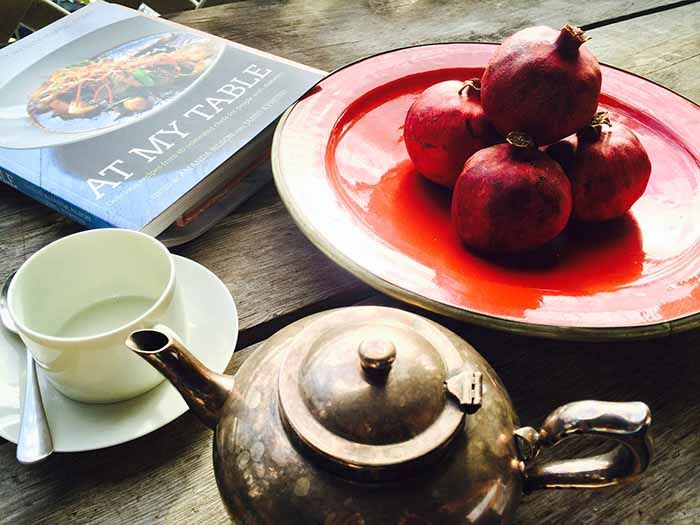
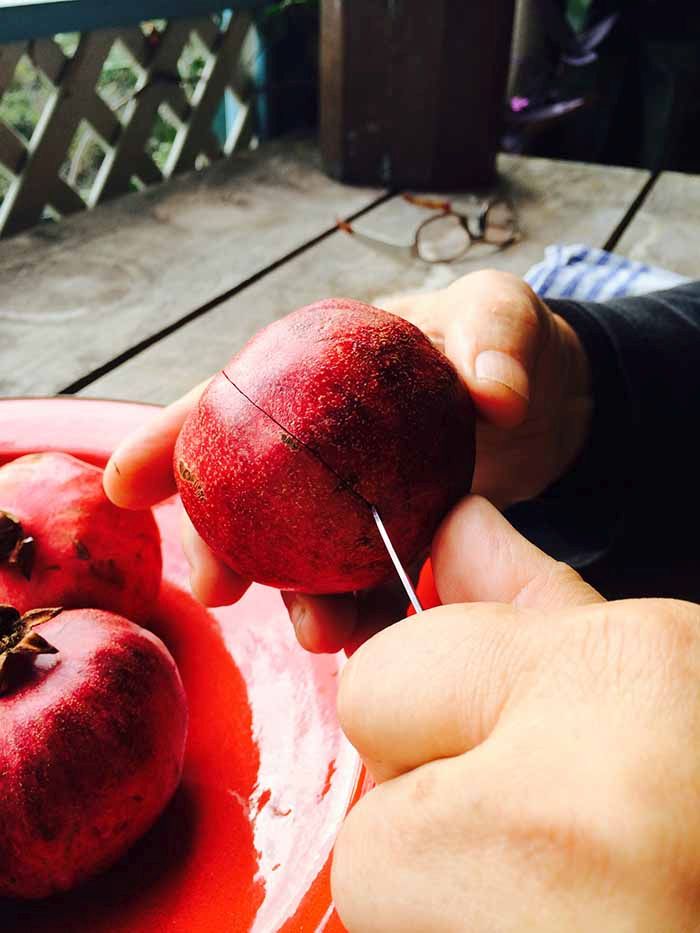
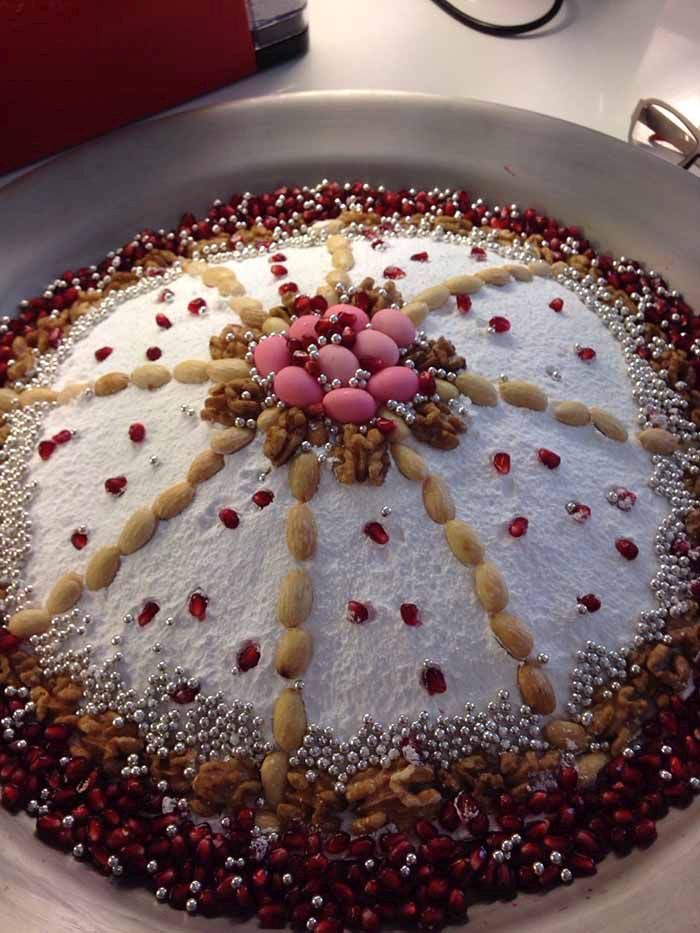
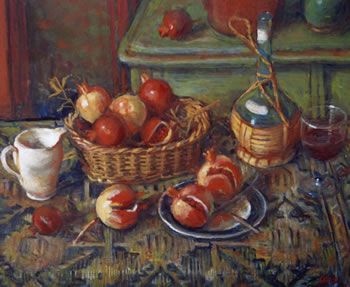
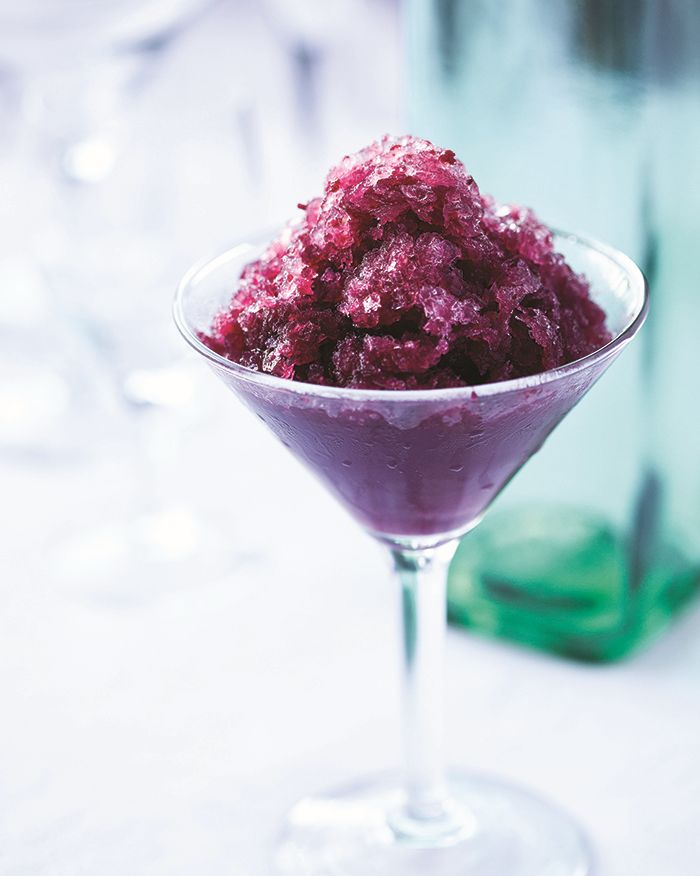
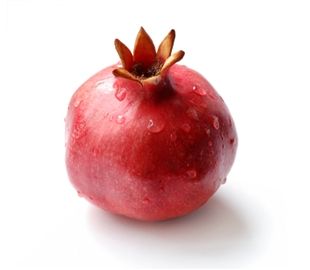
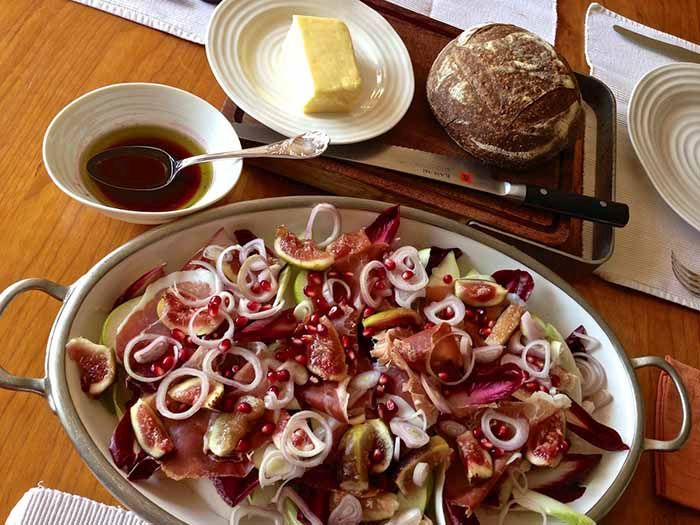
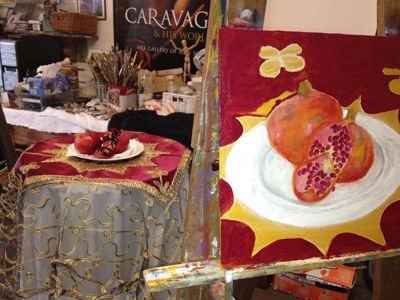
what an exquisite poem